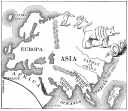Christmas Columbus and the New World
Part 1: How It All Came About Christopher Columbus is famous because he found something he wasn't looking for. In 1492, Columbus sailed across the Atlantic Ocean in search of India. What he found was something far different. He found the New World. How did this come about? It all started in Italy. Christopher Columbus was born in Genoa in 1451. His family didn't have a lot of many, and Christopher wasn't an only child. He didn't have much of an education until he was much older. Instead, he went to sea. He sailed around the Mediterranean and as far north as England and Ireland. When he was 25, he was shipwrecked and found his way ashore to Portugal, where he later lived with his brother. He met the woman who would be his wife in Portugal, too. Sadly, she died soon after their son, Diego, was born. After that, Columbus took his son to Spain.
Marco Polo said that Japan was only 1,500 miles east of China. Claudius Ptolemy, the great geographer of ancient Greece, had made two giant errors: He had said that Earth was smaller around than it really was, and he had said that the landmass of Europe and Asia was larger than it really was. As a result, Columbus was convinced that Japan was only 3,000 miles west of Portugal. And 3,000 miles was a distance that ships could travel in those days. Add to this the fact that trade routes overland from Europe to the Far East were too slow for many traders. Also add to this the fact that trade routes by sea from Europe to the Far East were still too slow for many traders. Finally, add to this the idea (which was generally accepted by this time) that Earth was round. So, Columbus decided that he wanted to get to the East by going west. He thought that if he sailed far enough west, he would eventually sail around the world enough to reach the East. Based on his calculations, Japan was only 3,000 miles away, after all. Next page > A Long Voyage > Page 1, 2, 3 |
|
Social Studies for Kids
copyright 2002–2025
David White



 During
his travels, Columbus had heard sailors' reports of land to
the west of the Madeira and Azores Islands, which were in
the Atlantic Ocean west of Portugal. He wanted to know more
and got maps and books on geography. (Fortunately, he had
learned Latin, the language used on most maps.) These books
and maps suggested, based on stories of
During
his travels, Columbus had heard sailors' reports of land to
the west of the Madeira and Azores Islands, which were in
the Atlantic Ocean west of Portugal. He wanted to know more
and got maps and books on geography. (Fortunately, he had
learned Latin, the language used on most maps.) These books
and maps suggested, based on stories of 
